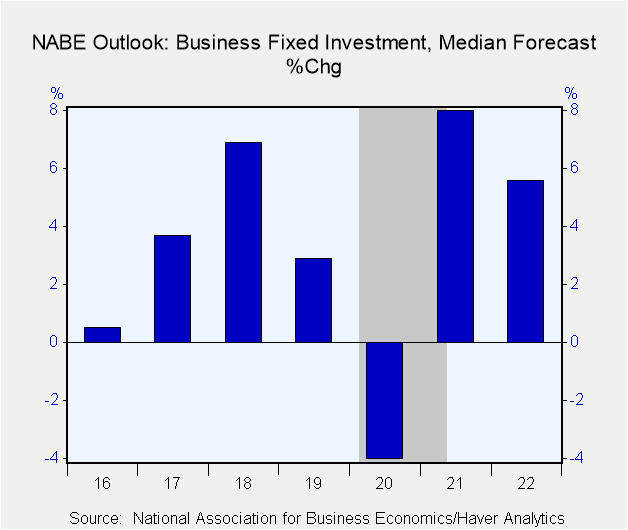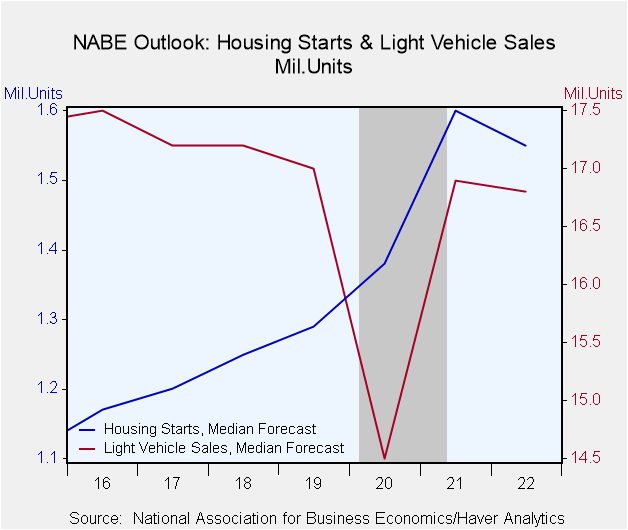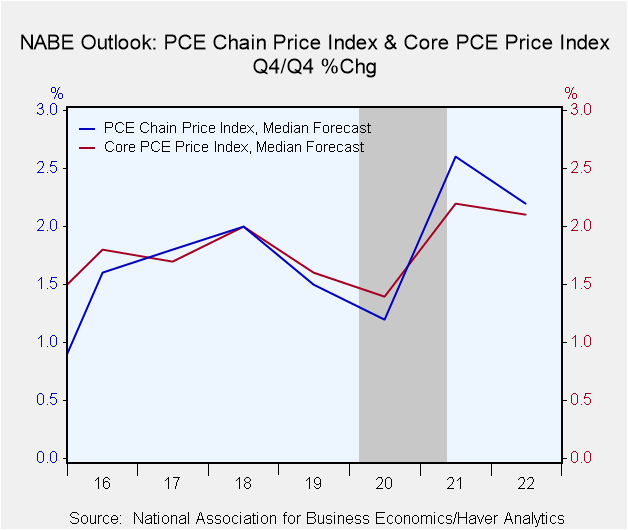 Global| May 26 2021
Global| May 26 2021NABE Lifts Economic Growth & Inflation Forecasts for 2021 & 2022
by:Tom Moeller
|in:Economy in Brief
Summary
• Firm economic growth lowers jobless rate. • Growth improvement spreads across sectors. • Inflation and market interest rate forecasts are raised. The National Association for Business Economics raised its 2022 real GDP forecast to [...]
• Firm economic growth lowers jobless rate.
• Growth improvement spreads across sectors.
• Inflation and market interest rate forecasts are raised.
The National Association for Business Economics raised its 2022 real GDP forecast to 4.4% from 4.0% expected in March. It also strengthened the 2021 GDP projection to 6.5% from 4.8%. Quarterly growth is expected to rise to 8.5% this quarter and average a strengthened 6.7% Q4/Q4. Four-quarter growth in 2022 of 2.8% compares to the earlier 3.0% expectation. Personal consumption expenditures are forecast to strengthen a little-changed 4.2% in 2022 after rising 7.4% this year, revised from 5.4%. Business fixed investment is expected to rise 5.6% next year, revised from 5.0%, after gaining 8.0% in 2021, revised from 6.6%. Expected growth of 4.5% in residential investment was little changed and is expected to follow a 14.0% 2021 gain, revised from 12.4%. Government spending growth is expected to slow to 1.7% this year, revised from 1.3%, after a 2.3% gain in 2021, revised from 0.7%. Deterioration in net exports is forecast to continue steadily next year. Slow recoveries abroad are expected to limit U.S. export growth to a little-changed 7.7% in 2022 versus a 5.5% rise in imports. In 2021, exports are projected to rise a lessened 6.0%, while imports are forecasted to surge an increased 13.0%. The expected rate of inventory investment is expected to double in 2022 after picking up this year from sharp decumulation in 2020.
Housing starts are forecasted to ease modestly next year to an average 1.55 million units, revised from 1.49 million units; this year's forecast was increased to 1.60 million starts, also from 1.49 million. Light vehicle sales of 16.8 million units in 2022 are expected to follow an upwardly revised 16.9 million sales this year. Sales will thus remain below the 2016 peak of 17.5 million. An average monthly gain in payroll employment of 281,000 next year was changed from 258,000. That should follow a 566,000 average gain in 2021, revised from 351,000. Expectations for the unemployment rate in 2022 place it at 4.3%, revised from 4.7% after 5.6% this year, revised from 5.8%.
The Consumer Price Index is projected to rise 2.3% Q4/Q4 in 2022, revised from 2.2% following a 2.8% gain this year, revised from 2.2%. Price inflation next year, as measured by the PCE price index, is expected to total 2.2%, revised from 2.1%, and 2.6% this year, revised from 2.0%. The chain PCE price index excluding food & energy should rise 2.1% next year (Q4/Q4), revised from 1.9%, after gaining 2.2% this year, revised from 1.8% in 2021. The cost of crude oil is expected to average a little-changed $60 per barrel at the end of 2022 after rising to $62 this year, revised from $55 per barrel.
The forecasted 2.10% interest rate on a ten-year Treasury note at the end of 2022 was revised from 1.80%, and compares to 1.90% at the end of this year, revised from 1.45% expected earlier. The Federal funds rate is projected to hold steady at 0.125% through the end of next year. After-tax corporate profits should rise a little-changed 5.0% in 2022 following a 12.2% strengthening in 2021, revised from 9.2%. The expected Federal government budget deficit should ease to $1.500 trillion in FY22 from an unrevised $3.20 trillion this year.
The figures from the latest NABE report can be found in Haver's SURVEYS database.
The Economic Outlook and Monetary Policy from Fed Vice Chair for Supervision Randal K. Quarles is available here.
| National Association For Business Economics | 2022 | 2021 | 2020 | 2019 | 2018 |
|---|---|---|---|---|---|
| Real GDP (% Chg. SAAR) | 4.4 | 6.5 | -3.5 | 2.2 | 3.0 |
| Personal Consumption Expenditures | 4.2 | 7.4 | -3.9 | 2.4 | 2.7 |
| Business Fixed Investment | 5.6 | 8.0 | -4.0 | 2.9 | 6.9 |
| Residential Investment | 4.5 | 14.0 | 6.1 | -1.7 | -0.6 |
| Gov't Consumption & Gross Investment | 1.7 | 2.3 | 1.1 | 2.3 | 1.8 |
| Change in Real Business Inventories (Bil. $) | 91.0 | 40.0 | -77.4 | 48.5 | 53.4 |
| Net Exports (Bil. $) | -1,234 | -1,220 | -926.0 | -917.6 | -877.7 |
| Housing Starts (Mil. Units) | 1.55 | 1.60 | 1.38 | 1.29 | 1.25 |
| Light Vehicle Sales (Mil. Units) | 16.8 | 16.9 | 14.5 | 17.0 | 17.2 |
| Payroll Employment Average Monthly Change (000s) | 281 | 566 | -785 | 168 | 193 |
| Civilian Unemployment Rate (%) | 4.3 | 5.6 | 8.1 | 3.7 | 3.9 |
| Consumer Price Index (Q4/Q4 %) | 2.3 | 2.8 | 1.2 | 2.0 | 2.2 |
| Chain Price Index for PCE (Q4/Q4 %) | 2.2 | 2.6 | 1.2 | 1.5 | 2.0 |
| Chain Price Index excl. Food & Energy (Q4/Q4 %) | 2.1 | 2.2 | 1.4 | 1.6 | 2.0 |
| Fed Funds Rate (%, Year-End) | 0.125 | 0.125 | 0.125 | 1.625 | 2.375 |
| 10-Year Treasury Note (%, Year-End) | 2.10 | 1.90 | 0.93 | 1.92 | 2.69 |
Tom Moeller
AuthorMore in Author Profile »Prior to joining Haver Analytics in 2000, Mr. Moeller worked as the Economist at Chancellor Capital Management from 1985 to 1999. There, he developed comprehensive economic forecasts and interpreted economic data for equity and fixed income portfolio managers. Also at Chancellor, Mr. Moeller worked as an equity analyst and was responsible for researching and rating companies in the economically sensitive automobile and housing industries for investment in Chancellor’s equity portfolio. Prior to joining Chancellor, Mr. Moeller was an Economist at Citibank from 1979 to 1984. He also analyzed pricing behavior in the metals industry for the Council on Wage and Price Stability in Washington, D.C. In 1999, Mr. Moeller received the award for most accurate forecast from the Forecasters' Club of New York. From 1990 to 1992 he was President of the New York Association for Business Economists. Mr. Moeller earned an M.B.A. in Finance from Fordham University, where he graduated in 1987. He holds a Bachelor of Arts in Economics from George Washington University.












